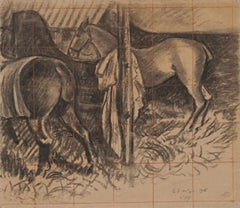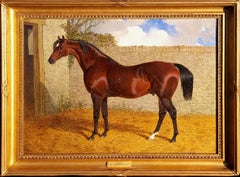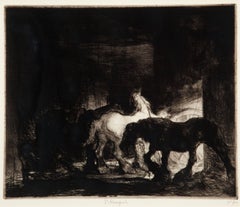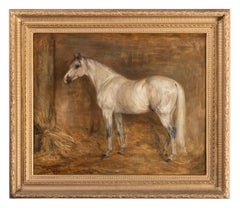Antique Stable
to
530
4,032
3,104
4,335
1,916
1,916
1,624
1,086
940
760
711
344
324
192
168
149
144
138
134
112
85
83
80
64
62
53
47
43
37
35
32
26
19
19
17
16
14
13
10
7
7
6
6
5
5
4
4
3
2
2
2
2
30
23
21
14
13
Sort By
Horses in Stable
By Georges Lemmen
Located in Fairlawn, OH
Horses in a Stable
Black chalk on tan wove paper, 1896
Signed with the estate stamp lower right
Category
1890s Impressionist Antique Stable
Materials
Chalk
Returning to the Stable.
By Edmund Blampied
Located in Storrs, CT
Returning to the Stable. 1920. Drypoint. Appleby 64. 8 3/4 x 12 1/4 (sheet 11 7/16 x 16 1/8
Category
1920s Modern Antique Stable
Materials
Drypoint, Etching
Mid 19th Century Interior of Stable with Horses, Dogs, and Stable Hand
Located in Soquel, CA
Wonderful mid 19th Century painting of a stable's interior with two horses, stable hand, two
Category
19th Century English School Antique Stable
Materials
Masonite, Oil, Linen
$9,500
H 47 in W 39 in D 3.5 in
'Partisan' in a Stable Yard
By John Frederick Herring Sr.
Located in Belgravia, London, London
'Partisan' in a Stable Yard (1830)
by John Frederick Herring Snr
British 1795-1865
Oil on Canvas
Category
19th Century Antique Stable
Materials
Canvas, Oil
Night Time in a Stable.
By Edmund Blampied
Located in Storrs, CT
Night Time in a Stable. 1927-28. Drypoint. Appleby 131. 10 1/8 x 12 1/8 (sheet 11 1/2 x 16 1/2
Category
Early 20th Century Modern Antique Stable
Materials
Drypoint, Etching
An Arabian mare in a stable
Located in Stoke, Hampshire
Robert L. Alexander R.S.A., R.S.W. (1840- 1923)
An Arabian mare in a stable
signed and dated 'R
Category
19th Century Victorian Antique Stable
Materials
Oil
Horse training with its stable lad
Located in PARIS, FR
Horse training with its stable lad
by Arthur Marie Gabriel comte du Passage (1838-1909)
A bronze
Category
Late 19th Century French School Antique Stable
Materials
Bronze
$32,498
H 13 in W 17.72 in D 7.68 in
Horse training with its stable lad
Located in PARIS, FR
(after) Arthur Marie Gabriel comte du Passage (1838-1909)
Horse training with its stable lad
A rare
Category
Late 19th Century French School Antique Stable
Materials
Bronze
The Farmers Stable, Victorian Oil Painting
Located in Cirencester, Gloucestershire
Artist/ School: Victorian British, after George Morland
Title: The Farmers Stable
Medium
Category
19th Century Victorian Antique Stable
Materials
Oil
Antique French Copper Engraving - Horse Stables
Located in Houston, TX
Crisp antique copper engraving of a unique floor plan of French horse stables from Recueil
Category
1780s Antique Stable
Materials
Ink, Paper
A horse being led from a stable
By James Seymour
Located in Stoke, Hampshire
James Seymour (1702-1752)
A horse being led from a stable
Mezzotint by Thomas Burford
Image size 10
Category
18th Century Old Masters Antique Stable
Materials
Mezzotint
Phoebe Stabler (1916) Antique Lead Bird Bath
Located in Wormelow, Herefordshire
A whimsical 1916 antique lead bird bath by late 19th/ early 20th century sculptor, Phoebe Stabler
Category
Early 20th Century English Edwardian Antique Stable
Materials
Metal, Lead
Attr. William Shayer Snr.- Oil, Stable Interior
By WILLIAM SHAYER SENIOR (1787-1879)
Located in Pewsey, GB
Attributed to William Shayer Snr. (1787 – 1879) A Stable interior with a horse and donkey by a
Category
1860s British Victorian Antique Stable
Materials
Papercord, Paint
Japanese Two Panel Screen: Horses in Stable
Located in Hudson, NY
A pair of captivating black and white horses, believed to define hard work and power in Japanese mythology, are beautifully rendered in this painting of mineral pigments on mulberry ...
Category
Early 19th Century Japanese Antique Stable
Materials
Bronze, Gold Leaf
Japanese Six-Panel Screen Horses in Stable
Located in Hudson, NY
Kano School painting of horses in stabile, with a monkey. Mineral pigments on mulberry paper with silk brocade border.
Category
Late 18th Century Japanese Edo Antique Stable
Materials
Silk, Wood, Paper
William Shayer Framed Oil Painting of Stable Scene
Located in Queens, NY
English Victorian (19th Cent) oil painting of a stable scene by William Shayer (1787-1879), signed
Category
19th Century British Victorian Antique Stable
Materials
Canvas
In the Stable - Lithograph by Luigi Gioli - 1880
By Luigi Gioli
Located in Roma, IT
In the Stable is an original Lithograph realized in the 1880 Century by Luigi Gioli.
Good
Category
1880s Modern Antique Stable
Materials
Lithograph
$315 Sale Price
25% Off
H 6.3 in W 9.45 in D 0.08 in
Georges Pacouil (1903-1996) - 1920 Oil, The Stables
Located in Corsham, GB
Signed and dated to the lower right. On canvas.
Category
Early 20th Century Antique Stable
Materials
Oil
$298 Sale Price
20% Off
H 14.97 in W 18.12 in
18th Oil Painting Horses Feeding at the Stables
By James Seymour
Located in London, GB
James Seymour (1702–1752)
Feeding Time in the Stables
Oil on canvas
32 x 38 inches inc. frame
Category
18th Century Old Masters Antique Stable
Materials
Oil
English Naive 19th Century - Cow in a stable interior
Located in London, GB
The English Naive school of the 19th century works are characterized by a simple, direct, and unschooled approach to painting. While not a formal “school” with organized membership, ...
Category
19th Century Antique Stable
Materials
Canvas, Oil
$3,505
H 25.01 in W 32.49 in
Carter Stabler Adams Chinese Blue Glazed Bowl on Stand
By Poole Pottery
Located in Bishop's Stortford, Hertfordshire
Stabler Adams and dating from around 1920, The earthenware bowl is of rounded shape with a narrow stem
Category
1920s Chinese Art Deco Antique Stable
Materials
Ceramic
Follower of George Morland - 1901 Watercolour, The Grooming Stable
Located in Corsham, GB
A dramatic stable interior scene in watercolour, showing a man hurriedly grooming a distressed
Category
Early 20th Century Antique Stable
Materials
Watercolor
$308 Sale Price
20% Off
H 20.48 in W 21.86 in
"Woman tending to her sheep in a rustic stable setting"
Located in Edinburgh, GB
in a rustic stable setting, bathed in soft, natural light that enhances the depth and texture of the
Category
19th Century Antique Stable
Materials
Canvas, Oil
$6,018
H 22.84 in W 25.6 in
Early 20th Century Country House Horse Stable Name Plaques Signs
Located in Lowestoft, GB
A charming collection of six, hand painted Horse stable name plaques.
Each plaque is pine, with
Category
Early 20th Century English Edwardian Antique Stable
Materials
Pine
$974 / set
H 1.38 in W 12.01 in D 0.4 in
"Peasant Woman Driving Pigs into a Stable" original etching
By Charles-Emile Jacque
Located in Henderson, NV
Medium: original etching. This impression on wove paper was printed in 1885 for the Sylvester R. Koehler portfolio of etchings and published by Cassell & Company. Plate size: 5 x 6 1...
Category
1880s Antique Stable
Materials
Etching
$150
H 5.12 in W 6.54 in
19th century, Grey Horse in a Stable, oil, Albert Clark
By Albert Clark
Located in York, GB
A 19th century oil painting on canvas of a Grey Horse in a Stable.
Signed and dated 1890, housed
Category
19th Century Old Masters Antique Stable
Materials
Oil
$4,907
H 22.05 in W 26.38 in
Léopold Desbrosses (1821-1908) French Engraving "Stables Interior in Septeuil"
Located in Nottingham, GB
-1908) French Engraving "Stables Interior in Septeuil"
Category
19th Century Antique Stable
Materials
Paper
$385
H 11.03 in W 7.49 in D 0.04 in
Original Art Deco Beech Chair, Fischel, Stable Construction, Czechia, 1920s
By Fischel
Located in Brandys nad Labem, Středočeský kraj
Material: Beech
Very well preserved condition.
Stable construction.
In pristine original condition, the
Category
1920s Czech Art Deco Antique Stable
Materials
Wood, Beech
$240
H 34.26 in W 16.15 in D 20.87 in
Horse portrait oil painting of a chestnut hunter in a stable
By George Wright
Located in Nr Broadway, Worcestershire
George Wright
British, (1860-1944)
Chestnut Hunter in a Stable
Oil on canvas, signed, old label
Category
Early 20th Century Victorian Antique Stable
Materials
Canvas, Oil
$5,605
H 22.75 in W 28.5 in D 2.25 in
Restored Biedermeier Seating Set, Oak Walnut, Stable Constructon, Austria, 1840s
Located in Brandys nad Labem, Středočeský kraj
)
Inlaid patterns.
Completely restored stable construction.
Revitalized original polish.
The springs are in
Category
1840s Austrian Biedermeier Antique Stable
Materials
Fabric, Upholstery, Wood, Oak, Walnut
$7,522 / set
H 36.23 in W 51.58 in D 26.38 in
'Avontes' a bay stallion with a groom in a stable interior
By Charles Augustus Henry Lutyens
Located in Stoke, Hampshire
Charles Augustus Henry Lutyens (1829-1915)
Avontes, a bay stallion with a groom in a stable
Category
19th Century Victorian Antique Stable
Materials
Oil
$22,433
H 49 in W 59 in
Stable - Etching on Paper by Jules Hereau - Late 19th Century
Located in Roma, IT
Stable is an original etching on paper artwork realized by Jules Hereau.
The state of preservation
Category
Late 19th Century Antique Stable
Materials
Etching
$315 Sale Price
25% Off
H 5.91 in W 7.68 in D 0.04 in
English Oil on Canvas With Horse In Stable, Circa 1866
Located in Charleston, SC
English oil on canvas painting of horse in stable with the gilt & burl frame. Signed & Dated "J
Category
1860s English Victorian Antique Stable
Materials
Gold Leaf
A saddled hunter tethered to a stable door, a landscape beyond
Located in Stoke, Hampshire
Jacques-Laurent Agasse (1767-1849)
A saddled hunter tethered to a stable door, a landscape beyond
Category
18th Century Old Masters Antique Stable
Materials
Oil
$30,845
H 25 in W 28.5 in
Bloomsbury Taste Art Deco Poole Studio Pottery signed Carter Stabler Adams
By James Poole & Co
Located in Sharon, CT
Signed on bottom, with a illegible Poole Mark and incised numerals.
Designed by John Adams
Featured in the 1923 Decorative Art Yearbook.
Category
1920s English Arts and Crafts Antique Stable
Materials
Ceramic
'Attilla' A Chestnut Horse in a Stable. Oil on canvas
By John Frederick Herring Sr.
Located in St. Albans, GB
extraction. At first he was a sign and coach painter. He then worked as a stable boy and coachman in
Category
1840s Victorian Antique Stable
Materials
Oil
$27,691
H 36 in W 44 in D 3 in
Jack Russell Terrier Dogs Barn Stable Interior Antique Signed English Painting
Located in Cirencester, Gloucestershire
Jack Russell Terrier Dogs
English artist, signed and dated 1913
signed oil painting, framed
framed: 15 x 18 inches
painting: 12 x 15 inches
Provenance: private collection, UK
Condit...
Category
Early 20th Century English School Antique Stable
Materials
Oil
$1,275 Sale Price
30% Off
H 15 in W 18 in
Horse portrait oil painting of a fleabitten grey horse in a stable
By George Wright
Located in Nr Broadway, Worcestershire
George Wright
British, (1860-1944)
Fleabitten Grey Horse in a Stable
Oil on canvas, signed, old
Category
Early 20th Century Victorian Antique Stable
Materials
Canvas, Oil
$5,608
H 22.75 in W 28.5 in D 2.25 in
English School 19th Century Oil - Mother & Child Feeding Animals Stable Interior
Located in Cirencester, Gloucestershire
donkey in a stable
Medium: oil on canvas, framed
actual canvas size: 25.5 x 21.25 inches
Provenance
Category
19th Century Victorian Antique Stable
Materials
Oil
$1,542
H 25.5 in W 21.25 in
Mare and Foal in a Stable Interior, James Ward RA (1769 - 1859)
By James Ward
Located in London, GB
painting Mare and Foal in a Stable Interior. This work embodies Ward's expertise in portraying animals with
Category
18th Century Antique Stable
Materials
Canvas, Oil
$8,412
H 22.05 in W 25.99 in
"The Country Stable" 18th Century Antique Mezzotint Engraving by William Ward
By George Morland
Located in Carmel, CA
"The Country Stable" After a painting by George Morland. 1763-1804. - Mezzotint engraving by
Category
Late 18th Century Realist Antique Stable
Materials
Engraving, Mezzotint
$5,000
H 20.75 in W 26 in D 0.07 in
Henry Samuel Teed (1883-1916) - Framed Watercolour, Behind the Stable Yard
Located in Corsham, GB
Original watercolour by Henry Samuel Teed (1883-1916). Signed and dated (1907) to the lower right. Presented in a gilt-effect frame. On fibrous paper.
Category
Early 20th Century Antique Stable
Materials
Watercolor
$238 Sale Price
20% Off
H 18.31 in W 23.63 in
Cow and Chickens in Stable /// Thomas Sidney Cooper British Farm Animal Painting
By Thomas Sidney Cooper
Located in Saint Augustine, FL
Artist: Thomas Sidney Cooper (English, 1803-1902)
Title: "Cow and Chickens in Stable"
*Signed and
Category
1870s Victorian Antique Stable
Materials
Paint, Oil, Panel, Wood Panel, Board, Wood
19th century English portrait of a White/grey hunter in a stable
By Charles Towne
Located in Woodbury, CT
English 19th century portrait of a White / Grey hunter in a stable.
Charles Towne was born in
Category
1820s Old Masters Antique Stable
Materials
Oil, Canvas
$19,600 Sale Price
20% Off
H 31 in W 33 in
Return to the Stables, Gates Mills, Ohio, Summer Landscape with Bridge & River
Located in Beachwood, OH
Frank Luis Jirouch (American, 1878-1970)
Return to the Stables, Gates Mills, Ohio, c. 1925-30
Oil
Category
1920s American Impressionist Antique Stable
Materials
Oil
Victorian Oil Painting Blacksmith Forge with Figures and Horse in Stable Framed
Located in ludlow, GB
Victorian Oil Painting of a Blacksmith Forge with Figures and a Horse in a Smithy Interior. Small Oil on Panel in its original gilt frame in excellent condition. A real find, depic...
Category
Mid-19th Century Victorian Antique Stable
Materials
Oil
$4,136
H 10 in W 13 in D 2 in
Horse Painting: "Horse at Stable with Hay" -Julius Paul Junghanns (1876-1958)
Located in SANTA FE, NM
Antique Horse Painting
"Horse at Stable with Hay"
Julius Paul Junghanns (German, 1876-1958)
Oil on
Category
Early 20th Century Post-Impressionist Antique Stable
Materials
Canvas, Oil, Board
$4,885
H 19 in W 25 in D 1.75 in
Bay race horse in a stable, William Osborne RHA, Irish Artist, 1823 - 1901
By William Osborne
Located in London, GB
in a stable, captured in rich oil on canvas. The scene evokes a sense of realism and attention to
Category
Late 19th Century Antique Stable
Materials
Canvas, Oil
$10,095
H 23.43 in W 27.37 in
Rare Pair of Thonet Rattan Chairs, Made in 1890, Stable and Good Condition
By Thonet, Michael Thonet
Located in Stockholm, SE
it a unique addition for collectors or enthusiasts of vintage Thonet furniture. In stable and good
Category
1890s Swedish Vienna Secession Antique Stable
Materials
Rattan, Bentwood
$2,886 / set
H 35.44 in W 16.15 in D 16.54 in
Large Early 1800's English Oil Painting Figures Carousing in Stable Interior
Located in Cirencester, Gloucestershire
Stable Interior
Medium: oil painting on canvas, unframed.
Canvas: 25.25 x 30 inches
Provenance
Category
Early 19th Century Victorian Antique Stable
Materials
Oil
$1,814 Sale Price
82% Off
H 25.25 in W 30 in D 1 in
Early 1800's English Oil Painting The Country Stable Groom Horse & Figures
Located in Cirencester, Gloucestershire
Stable
Medium: oil on canvas, framed
actual canvas size: 25. x 30 inches
framed: 34.75 x 40 inches
Category
Early 19th Century Victorian Antique Stable
Materials
Oil
$1,261
H 34.75 in W 40 in D 4.25 in
"Interior of a Stable" William Hart, Hudson River School Antique, Boy and Horse
By William Hart
Located in New York, NY
William M. Hart (1823 - 1894)
Interior of a Stable
Oil on canvas
17 x 12 inches
Provenance
Category
19th Century Hudson River School Antique Stable
Materials
Canvas, Oil
$60,000 Sale Price
20% Off
H 28.5 in W 23.5 in
Coastal Cliffs of Port Jackson and Governor's Stables in Sydney, New South Wales
Located in Langweer, NL
Title: Coastal Cliffs of Port Jackson and Governor's Stables in Sydney, New South Wales
Category
1830s Antique Stable
Materials
Paper
$228
H 13.47 in W 9.93 in D 0.01 in
Antique Dog Painting Collies in Horse Stable w/ Saddle and Blanket, 19th century
Located in SANTA FE, NM
Antique Dog Painting "Collies in Horse Stable with Saddle and Blanket"
Auguste Vimar (French 1851
Category
Early 1900s Realist Antique Stable
Materials
Canvas, Oil
$10,000
H 28 in W 25.5 in D 4 in
19th Century English Antique Bay Hunter horse in a stable, called Business
By Henry Calvert
Located in Woodbury, CT
Henry Calvert was an animal painter, particularly of the sporting variety and best known for his depictions of horses, hunting scenes and equestrian hunting portraits.
He was born in...
Category
1840s Victorian Antique Stable
Materials
Canvas, Oil
$14,000 Sale Price
20% Off
H 32.5 in W 37.5 in
Oil on Board Painting of Horse in Stable by Louis Nadler, Early 20th Century
Located in Atlanta, GA
gleams under the light filtering into the stable, its form sharply outlined against the pale stone walls
Category
Early 20th Century American Antique Stable
Materials
Wood, Giltwood
$4,500
H 15.75 in W 19.75 in D 2 in
Terrier Dogs chasing Rat in Stable Barn Interior signed English Oil Painting
Located in Cirencester, Gloucestershire
Frank Cassell (British 19th century)
signed oil painting on canvas, framed
framed: 18.5 x 22 inches
canvas: 12 x 16 inches
provenance: private collection, England
condition: overall...
Category
19th Century Victorian Antique Stable
Materials
Canvas, Oil
$1,471 Sale Price
30% Off
H 18.5 in W 22 in
Terriers in Stable Barn Interior Rat Catching Signed 1920's English Oil Painting
Located in Cirencester, Gloucestershire
The Rat Catcher
English School, 1920's
signed, dated, "R. Esom"
oil on canvas, framed
framed: 12 x 16 inches
canvas : 8 x 12 inches
Provenance: private collection, Cotswolds, Englan...
Category
1920s English School Antique Stable
Materials
Oil
1920's EnglishTerriers in Stable Barn Interior Rat Catching Signed 1920's English Oil Painting, 1923
$931 Sale Price
30% Off
H 12 in W 16 in
- 1
- ...
Get Updated with New Arrivals
Save "Antique Stable", and we’ll notify you when there are new listings in this category.
Antique Stable For Sale on 1stDibs
Find many varieties of an authentic antique stable available at 1stDibs. Each antique stable for sale was constructed with extraordinary care, often using wood, metal and oak. Your living room may not be complete without an antique stable — find older editions for sale from the 18th Century and newer versions made as recently as the 20th Century. Each antique stable bearing Victorian, Arts and Crafts or Georgian hallmarks is very popular. Many designers have produced at least one well-made antique stable over the years, but those crafted by Thonet, Liberty of London and Carle Vernet (Antoine Charles Horace Vernet) are often thought to be among the most beautiful.
How Much is a Antique Stable?
An antique stable can differ in price owing to various characteristics — the average selling price 1stDibs is $3,142, while the lowest priced sells for $31 and the highest can go for as much as $2,482,247.
More Ways To Browse
French Marble Top Bakers Or Pastry Table
Chairs Made In Sweden
Root Table
Half Columns
Antique Distressed Cabinets
Swedish Antique Cabinet
Tall French Doors
Antique Door Knob
Single Door Display Cabinets
Mahogany Secretary
Storage Cubby
Spanish Baroque Table
Antique Primitive Tables
Victorian Front Door
George Iii Style Mahogany
Cubby Cabinet
Wood Carved Double Doors
Carved Secretary






